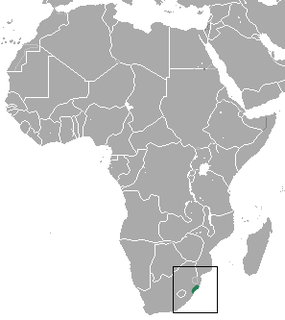
Villa's gray shrew is a shrew native to northeastern Mexico, where it is called musaraña.
Ecnomiohyla echinata is a species of frog in the family Hylidae. It is endemic to Sierra Juárez, Oaxaca, Mexico. Its natural habitat is cloud forest at around 2,000 m (6,600 ft) asl. It relies on humid habitats, in particular the vegetation along streams as well as epiphytic plants where it can find refuge. It breeds in streams. It is threatened by habitat loss and the spread of chytridiomycosis.
Ecnomiohyla fimbrimembra is a species of frog in the family Hylidae. It is found in Costa Rica and Panama. Its natural habitat is subtropical or tropical moist montane forests. It is threatened by habitat loss and the spread of chytridiomycosis.

Cope's brown treefrog or fringe-limbed treefrog is a species of frog in the family Hylidae. It is found in Costa Rica, Nicaragua, and Panama. Its natural habitats are subtropical or tropical moist lowland forests and subtropical or tropical moist montane forests. It is threatened by habitat loss.
Ecnomiohyla minera is a species of frog in the family Hylidae. It is endemic to Guatemala. Its natural habitat is subtropical or tropical moist montane forests. It is threatened by habitat loss.
Ecnomiohyla phantasmagoria is a species of frog in the family Hylidae. It is found in Colombia and Ecuador. Its natural habitat is subtropical or tropical moist lowland forests. It is threatened by habitat loss.

Ecnomiohyla thysanota, also known as Cerro Mali treefrog, is a species of frog in the family Hylidae. It is endemic to Panama where it is known from its type locality, Cerro Malí in eastern Serranía de Darién, near the border to Colombia, where it might also occur. This arboreal species is only known from a single specimen, the holotype.

Tepuihyla tuberculosa, commonly known as the Canelos treefrog, is a species of frog in the family Hylidae. It is found in the upper Amazon Basin in western Brazil, Colombia, Ecuador, and Peru. It is a rare canopy species found in primary forest; beyond the habitat requirements, its biology is unknown.
Ecnomiohyla valancifer is a species of frog in the family Hylidae. It is endemic to the slopes of the San Martin Tuxtla volcano, in the Sierra de los Tuxtlas range in southern Veracruz state, Mexico. Its natural habitats are tropical rainforests. It is threatened by habitat loss.
Hyperolius zonatus is a species of frog in the family Hyperoliidae. It is found in Ivory Coast, Guinea, Sierra Leone, and possibly Liberia. Its natural habitats are subtropical or tropical moist lowland forests, swamps, and intermittent freshwater marshes. It is threatened by habitat loss.

Hombron's kingfisher or the blue-capped kingfisher is a species of bird in the family Alcedinidae endemic to the Philippines and found only on Mindanao. It is one of the most colorful kingfishers in the country having a dark blue cap and wings with rufous spots, a striped rufous belly, white chin and red bill. Its natural habitats are on the upper ranges of tropical moist lowland forest and tropical moist montane forests. It is threatened by habitat loss.

The dark-footed mouse shrew is a species of mammal in the family Soricidae found in Mozambique, South Africa, Eswatini, and Zimbabwe. Its natural habitat is subtropical or tropical moist montane forests. It is threatened by habitat loss. It was formerly sometimes called the dark-footed forest shrew.

Sclater's mouse shrew is a species of mammal in the family Soricidae endemic to South Africa. Its natural habitats are subtropical or tropical moist lowland forests and swamps. It is threatened by habitat loss.

Fardoulis's blossom bat is a species of bat in the Pteropodidae family. It is endemic to the Solomon Islands. Its natural habitat is subtropical or tropical moist lowland forests. It is threatened by habitat loss.

Hayman's dwarf epauletted fruit bat or Hayman's epauletted fruit bat is a species of megabat in the family Pteropodidae. It is found in Angola and Democratic Republic of the Congo. Its natural habitats are subtropical or tropical moist lowland forest and moist savanna. It is threatened by habitat loss.

The ornate flying fox is a species of flying fox in the family Pteropodidae. It is endemic to New Caledonia. Its natural habitat is subtropical or tropical dry forests. It is threatened due to habitat destruction and hunting, the former exacerbated by high roost-site fidelity.

The Philippine gray flying fox is a species of flying fox in the family Pteropodidae. It is found in Indonesia and the Philippines. Its natural habitat is subtropical or tropical dry forests. It is threatened by habitat loss.

The Comoro rousette is a species of megabat in the family Pteropodidae endemic to the Comoros Islands. Its natural habitats are subtropical or tropical moist lowland forests, caves, plantations, and urban areas. It is threatened by habitat loss.

Ecnomiohyla rabborum, commonly known as Rabbs' fringe-limbed treefrog, is a possibly extinct species of frog in the family Hylidae. They were relatively large frogs that inhabited the forest canopies of central Panama. Like other members of the genus Ecnomiohyla, they were capable of gliding by spreading their enormous and fully webbed hands and feet during descent. The males of the species were highly territorial and would guard water-filled tree holes used for breeding. They were also the ones responsible for guarding and caring for the young, including providing food. They were the only known species of frog where the tadpoles derived nutrition by feeding on the skin cells of their fathers.

Rheohyla is a genus of frogs in the family Hylidae. As currently recognized, it is monotypic, containing only Rheohyla miotympanum, also known as the small-eared hyla or small-eared treefrog. However, the nominal species likely is a complex of more than one species. It is endemic to eastern and central Mexico. The generic name refers to streams, the breeding habitat of this frog. The specific name is derived from Greek meion, a diminutive prefix, together with Greek tympanon (='drum') and refers to the small tympanum.














